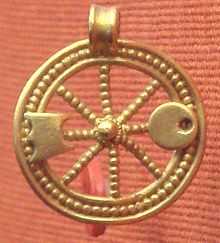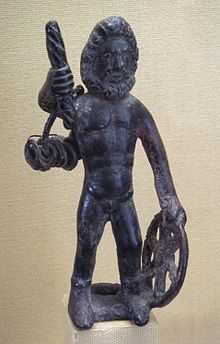Icovellauna
Icovellauna was a Celtic goddess worshipped in Gaul. Her places of worship included an octagonal temple at Le Sablon in Metz, originally built over a spring,[1] from which five inscriptions dedicated to her have been recovered;[2] and Trier, where Icovellauna was honoured in an inscription in the Altbachtal temple complex.[3][4]A[›] Both of these places lie in the valley of the Moselle river of eastern Gaul, in what are now Lorraine in France and Rhineland-Palatinate in Germany.
At the temple in Metz, a spiral staircase led down to the water level, allowing worshippers to leave offerings in the spring and/or to take the waters. A statuette of a local Gaulish Mercury was among the ex-votos deposited at the shrine.[1][5]
Following Joseph Vendryes, Miranda Green interprets the Gaulish root ico- as 'water' and characterizes Icovellauna as a "water-goddess" who "presided over the nymphaeum at Sablon in the Moselle Basin, a thermal spring-site".[6] Xavier Delamarre, however, considers this interpretation to be very improbable; on purely etymological grounds, he suggests that ico- might be the name of a bird, perhaps the woodpecker.[7] The root uellauno- has been variously interpreted, though the interpretation "chief, commander" has recently found favour;[8] see Vellaunus.
Notes
^ A: Although Jufer and Luginbühl also report a number of inscriptions to Icovellauna at Malzéville,[9] it has been suggested that this is an error on their part and that the inscriptions in question belong at Le Sablon in Metz.[10] The Epigraphik-Datenbank Clauss/Slaby has no records of any inscriptions from Malzéville published in CIL or similar publications.[11]
References
Works cited
- ↑ 1.0 1.1 Dyfed Lloyd Evans (2005). "Icovellauna: a Gaulish Goddess (Divine Pourer of the Waters)" from www.celtnet.org.uk, accessed 10 September 2006.
- ↑ CIL 13: 4294-4298. Of these, only CIL 13: 4294 is complete.
- ↑ CIL 13: 3644.
- ↑ Edith Mary Wightman (1970). Roman Trier and the Treveri. Rupert Hart-Davis, London, p.217.
- ↑ Le Sablon › L'histoire › Période gallo-romaine. Includes a line drawing of Icovellauna's sacred well in Metz. Retrieved on 2010-02-27.
- ↑ Miranda Green (1986). The Gods of the Celts. Alan Sutton, Gloucs. ISBN 0-389-20672-5. pp.85, 165.
- ↑ Xavier Delamarre (2003). Dictionnaire de la langue gauloise : Une approche linguistique du vieux-celtique continental, 2e édition. Éditions Errance. ISBN 2-87772-237-6. p.187. (French)
- ↑ Xavier Delamarre (op. cit.), p.310.
- ↑ Nicole Jufer & Thierry Luginbühl (2001). Les dieux gaulois : répertoire des noms de divinités celtiques connus par l'épigraphie, les textes antiques et la toponymie. Editions Errance, Paris. ISBN 2-87772-200-7. p.45; pp.50,70.
- ↑ Scrupulum (2007-03-19). Icovellauna: la bonne eau ou la grande Victoire? (French) Retrieved on 2010-02-27.
- ↑ Epigraphik-Datenbank Clauss/Slaby. Retrieved on 2010-02-27.
Further reading
- J-M. Demarolle. "Les eaux et le sacré dans la Lorraine antique". In L'eau en Gaule, rites sacrés et thermalisme. Dossiers d'Archéologie n° 174, 1 September 1992.

